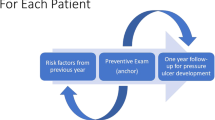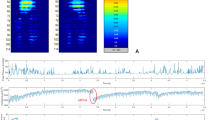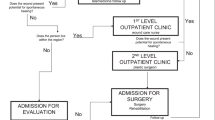Abstract
Design
Cohort study embedded in a clinical trial.
Setting
Community, Bangladesh.
Objectives
To determine the incidence, severity and time course of pressure injuries over the first two years following discharge from hospital in people with spinal cord injuries (SCI) in Bangladesh.
Methods
Participants (n = 186) were contacted by telephone 39 times and assessed face-to-face 4 to 6 times over the two years following discharge. At each point of contact the presence and severity of pressure injuries were determined using the Pressure Ulcer Scale for Healing (PUSH). Survival analyses were conducted to determine the time course of development of pressure injuries and recovery from pressure injuries. Lasso regression was used to construct multivariable prediction models.
Results
Seventy-seven participants (41%; 95% CI 34% to 49%) developed at least one pressure injury in the first two years after discharge (incidence rate 0.27 per person-year, 95% CI 0.22 to 0.34). Most pressure injuries were on the sacrum (23%). Pressure injuries took a median (IQR) of 40 (29 to 57) days to heal. The median (IQR) peak PUSH score was 11.0/17 (8.0 to 13.5). The multivariable prediction models had poor predictive properties (maximum c-statistic 0.75).
Conclusion
Pressure injuries impose a large health burden on people with SCI in Bangladesh. However, they are difficult to predict, treat and prevent. Further research is needed to identify who is at most risk and to find solutions for the treatment and prevention of pressure injuries in Bangladesh and other low-middle income countries.
Similar content being viewed by others

Log in or create a free account to read this content
Gain free access to this article, as well as selected content from this journal and more on nature.com
or
Data Archiving
De-identified individual participant data will be made available in response to reasonable requests.
References
Zakrasek EC, Creasey G, Crew JD. Pressure ulcers in people with spinal cord injury in developing nations. Spinal Cord. 2015;53:7–13.
Hossain MS, Islam MS, Rahman MA, Glinsky JV, Herbert RD, Ducharme S, et al. Health status, quality of life and socioeconomic situation of people with spinal cord injuries six years after discharge from a hospital in Bangladesh. Spinal Cord. 2019;57:652–61.
Arora M, Harvey LA, Glinsky JV, Chhabra HS, Hossain MS, Arumugam N, et al. Cost-effectiveness analysis of telephone-based support for the management of pressure ulcers in people with spinal cord injury in India and Bangladesh. Spinal Cord. 2017;55:1071–8.
Regan MA, Teasell RW, Wolfe DL, Keast D, Mortenson WB, Aubut JA, et al. A systematic review of therapeutic interventions for pressure ulcers after spinal cord injury. Arch Phys Med Rehabil. 2009;90:213–31.
Hossain MS, Rahman MA, Herbert RD, Quadir MM, Bowden JL, Harvey LA. Two-year survival following discharge from hospital after spinal cord injury in Bangladesh. Spinal Cord. 2016;54:132–6.
Chen HL, Cai JY, Du L, Shen HW, Yu HR, Song YP, et al. Incidence of pressure injury in individuals with spinal cord injury: a systematic review and meta-analysis. J Wound Ostomy Cont Nurs. 2020;47:215–23.
Shiferaw WS, Akalu TY, Mulugeta H, Aynalem YA. The global burden of pressure ulcers among patients with spinal cord injury: a systematic review and meta-analysis. BMC Musculoskelet Disord. 2020;21:334. https://doi.org/10.1186/s12891-020-03369-0.
Raghavan P, Raza WA, Ahmed YS, Chamberlain MA. Prevalence of pressure sores in a community sample of spinal injury patients. Clin Rehabil. 2003;17:879–84.
Hu X, Zhang X, Gosney JE, Reinhardt JD, Chen S, Jin H, et al. Analysis of functional status, quality of life and community integration in earthquake survivors with spinal cord injury at hospital discharge and one-year follow-up in the community. J Rehabil Med. 2012;44:200–5.
Madasa V, Boggenpoel B, Phillips J, Joseph C. Mortality and secondary complications four years after traumatic spinal cord injury in Cape Town, South Africa. Spinal Cord Ser Cases. 2020;6:84 https://doi.org/10.1038/s41394-020-00334-w.
Garber SL, Rintala DH. Pressure ulcers in veterans with spinal cord injury: a retrospective study. J Rehabil Res Dev. 2003;40:433–42.
Saladin LK, Krause JS. Pressure ulcer prevalence and barriers to treatment after spinal cord injury: comparisons of four groups based on race-ethnicity. NeuroRehabilitation. 2009;24:57–66.
Irgens I, Hoff JM, Jelnes R, Alexander M, Stanghelle JK, Thoresen M, et al. Spinal cord injury and development of pressure injury during acute rehabilitation in Norway: a national retrospective cross-sectional study. Spinal Cord. 2020;58:1069–79.
Gour-Provencal G, Mac-Thiong J-M, Feldman DE, Begin J, Richard-Denis A. Decreasing pressure injuries and acute care length of stay in patients with acute traumatic spinal cord injury. J Spinal Cord Med. 2020 Feb:1–9. https://doi.org/10.1080/10790268.2020.1718265.:1-9.
van der Wielen H, Post MWM, Lay V, Glasche K, Scheel-Sailer A. Hospital-acquired pressure ulcers in spinal cord injured patients: time to occur, time until closure and risk factors. Spinal Cord. 2016;54:726–31.
Joseph C, Nilsson, Wikmar L. Prevalence of secondary medical complications and risk factors for pressure ulcers after traumatic spinal cord injury during acute care in South Africa. Spinal Cord. 2016;54:535–9.
Verschueren JHM, Post MWM, de Groot S, van der Woude LHV, van Asbeck FWA, Rol M. Occurrence and predictors of pressure ulcers during primary in-patient spinal cord injury rehabilitation. Spinal Cord. 2011;49:106–12.
Scheel-Sailer A, Wyss A, Boldt C, Post MW, Lay V. Prevalence, location, grade of pressure ulcers and association with specific patient characteristics in adult spinal cord injury patients during the hospital stay: a prospective cohort study. Spinal Cord. 2013;51:828–33.
Ash D. An exploration of the occurrence of pressure ulcers in a British spinal injuries unit. J Clin Nurs. 2002;11:470–8.
DeJong G, Hsieh CHJ, Brown P, Smout RJ, Horn SD, Ballard P, et al. Factors associated with pressure ulcer risk in spinal cord injury rehabilitation. Am J Phys Med Rehabil. 2014;93:971–86.
McKinley WO, Jackson AB, Cardenas DD, DeVivo MJ. Long-term medical complications after traumatic spinal cord injury: a Regional Model Systems Analysis. Arch Phys Med Rehabil. 1999;80:1402–10.
Johnson RL, Gerhart KA, McCray J, Menconi JC, Whiteneck GG. Secondary conditions following spinal cord injury in a population-based sample. Spinal Cord. 1998;36:45–50.
Chen Y, DeVivo MJ, Jackson AB. Pressure ulcer prevalence in people with spinal cord injury: age-period-duration effects. Arch Phys Med Rehabil. 2005;86:1208–13.
Stillman MD, Barber J, Burns S, Williams S, Hoffman JM. Complications of spinal cord injury over the first year after discharge from inpatient rehabilitation. Arch Phys Med Rehabil. 2017;98:1800–5.
Haisma JA, van der Woude LH, Stam HJ, Bergen MP, Sluis TA, Post MW, et al. Complications following spinal cord injury: occurrence and risk factors in a longitudinal study during and after inpatient rehabilitation. J Rehabil Med. 2007;39:393–8.
Kovindha A, Kammuang-Lue P, Prakongsai P, Wongphan T. Prevalence of pressure ulcers in Thai wheelchair users with chronic spinal cord injuries. Spinal Cord. 2015;53:767–71.
Deconinck H. The health condition of spinal cord injuries in two Afghan towns. Spinal Cord. 2003;41:303–9.
Lofvenmark I, Wikmar LN, Hasselberg M, Norrbrink C, Hultling C. Outcomes 2 years after traumatic spinal cord injury in Botswana: a follow-up study. Spinal Cord. 2017;55:285–9.
Lofvenmark I, Hasselberg M, Nilsson Wikmar L, Hultling C, Norrbrink C. Outcomes after acute traumatic spinal cord injury in Botswana: from admission to discharge. Spinal Cord. 2017;55:208–12.
Onigbinde AT, Ogunsanya GI, Oniyangi SO. Pressure ulcer incidence among high risk inpatients in Nigeria. Br J Nurs. 2012;21:S4–10.
Wannapakhe J, Arrayawichanon P, Saengsuwan J, Amatachaya S. Medical complications and falls in patients with spinal cord injury during the immediate phase after completing a rehabilitation program. J Spinal Cord Med. 2015;38:84–90.
Scovil CY, Ranabhat MK, Craighead IB, Wee J. Follow-up study of spinal cord injured patients after discharge from inpatient rehabilitation in Nepal in 2007. Spinal Cord. 2012;50:232–7.
Kawu AA, Alimi FM, Gbadegesin AAS, Salami AO, Olawepo A, Adebule TG, et al. Complications and causes of death in spinal cord injury patients in Nigeria. West Afr J Med. 2011;30:301–4.
Nogueira PC, Caliri MHL, Haas VJ. Profile of patients with spinal cord injuries and occurrence of pressure ulcer at a university hospital. Rev Lat Am Enferm. 2006;14:372–7.
Hossain MS, Harvey LA, Islam MS, Rahman MA, Muldoon S, Biering-Sorensen F et al. A community-based intervention to prevent serious complications and death 2 years after discharge in people with spinal cord injury in Bangladesh (CIVIC): a randomised trial. Spinal Cord. 2021;59:649–58.
Hossain MS, Harvey LA, Rahman MA, Muldoon S, Bowden JL, Islam MS, et al. Community-based interventions to prevent serious complications (CIVIC) following spinal cord injury in Bangladesh: protocol of a randomised controlled trial. BMJ Open. 2016;6:e010350.
Acknowledgements
The trial was funded by the Australian National Health and Medical Research Council (project grant APP1080259). PDC is a recipient of Australia Awards Scholarship offered by the Department of Foreign Affairs and Trade (DFAT), Australia. We acknowledge the assistance of the following people: Murali Dhakshinamurthy, Mohammad Muddasser, Md. Naushad Alam, Sarath Gudivada, Jitendra Rathore, Ambika Yoganathan, Faruq Ahmed, Md. Shahoriar Ahmed, SM Iftekhar Alam, Md. Jubair Hassan, Masud Ur Rahman, Pangkaz Kanti Dash, Habibur Rahman and Md. Gourab Hasan. The funder was not involved in any aspect of the study. PDC, RDH, and LAH have full access to all the data.
Author information
Authors and Affiliations
Contributions
PDC, LAH, RDH, and MSH conceived the study. LAH, MSH, RDH, SJ, and IDC secured funding. PDC, MSI, and MAR collected data. MSI, MAR, and PDC managed or contributed to the management of the site. LAH, RDH, and PDC conducted the statistical analyses. LAH, RDH, and PDC interpreted the results. PDC, LAH, and RDH wrote the first draft of the manuscript. MSH, MSI, MAR, JVG, HL, SJ, and IDC reviewed the manuscript.
Corresponding author
Ethics declarations
Competing interests
The authors declare no competing interests.
Ethics statement
Ethical approval was obtained from the ethics committees of CRP, Bangladesh and the University of Sydney, Australia. Written consent was obtained from all participants involved in the study. Institutional and governmental regulations concerning the ethical use of human volunteers were followed.
Additional information
Publisher’s note Springer Nature remains neutral with regard to jurisdictional claims in published maps and institutional affiliations.
Supplementary information
Rights and permissions
About this article
Cite this article
D Costa, P., Harvey, L.A., Hossain, M.S. et al. Incidence, severity and time course of pressure injuries over the first two years following discharge from hospital in people with spinal cord injuries in Bangladesh. Spinal Cord 60, 348–353 (2022). https://doi.org/10.1038/s41393-021-00732-3
Received:
Revised:
Accepted:
Published:
Issue date:
DOI: https://doi.org/10.1038/s41393-021-00732-3


